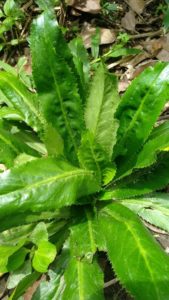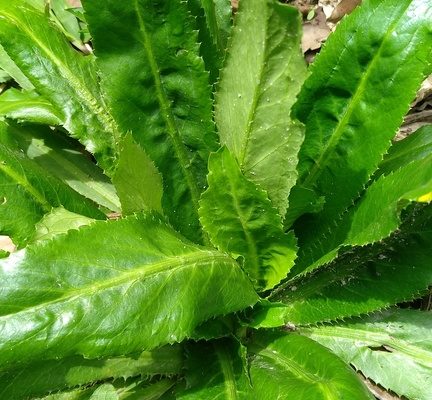Long Coriander

Scientific Name: Eryngium foetidum
Bahasa Indonesia: Ketumbar Jawa
Batak: Inggu
Basic Information:
Eryngium foetidum is a tropical perennial herb in the family Apiaceae. Common names include culantro (/kuːˈlɑːntroʊ/ or /kuːˈlæntroʊ/), recao, shadow beni, Mexican coriander, bhandhania, long coriander, sawtooth coriander, and ngò gai.[2][3] It is native to Mexico, the Caribbean, Central and South America, but is cultivated worldwide, sometimes being grown as an annual in temperate climates.
In the United States, the common name culantro sometimes causes confusion with cilantro, a common name for the leaves of Coriandrum sativum (also in Apiaceae), of which culantro is said to taste like a stronger
Culinary
E. foetidum is widely used in seasoning, marinating and garnishing in the Caribbean, particularly in Cuba, Dominican Republic, Puerto Rico, Trinidad and Tobago, Panama, Guyana, Suriname, and in Ecuador and Peru‘s Amazon regions. It is used extensively in Cambodia, Thailand, India, Vietnam, Laos, Myanmar and other parts of Asia as a culinary herb.[5] It dries well, retaining good color and flavor, making it valuable in the dried herb industry. It is sometimes used as a substitute for coriander, but it has a much stronger taste.
In the United States, E. foetidum grows naturally in Florida, Georgia, Hawaii, Puerto Rico, and the Virgin Islands.[6]
Health benefits of Culantro
Listed below are few of the popular benefits of consuming Culantro
1. Eliminate Bad Breath
On a general note, Veggies like parsley have been known to act as a remedy for bad breath. Since parsley and culantro belong to the same family of Apiaceae, Culantro can also be said to solve issues regarding bad breath. The fresh scent from shado Beni and high chlorophyll content suggest that it has some deodorizing effect. To use Culantro for bad breath, chew on fresh leaves after each course meal to eliminate the effect of Sulphur compounds which are the actual causes of bad breath.
2. Lowers Glucose
It has been revealed from research that leaves and stems from Culantro help lower blood sugar levels in animals. It can lower body Glucose because of Vitamin B2 (Riboflavin) present as a nutritional supplement. Riboflavin encourages a healthy Liver function which can release insulin hormone more effectively. Since a healthy liver is equal to a balanced body sugar level, it is only relevant to take a dietary supplement of shado beni with a meal. You can chop Culantro’s leaves coarsely, grind stems finely and then add this to salads, salsas, and smoothies to lower your sugar and reduce diabetic risk.
3. Asthma
Asthma is a common disease related with lungs. It intensely affects people living in industrialized areas where there is a prevalence of heavy metals, dust, and toxic gas emissions. However, recent researchers have found that plants are excellent sources of medicine that can help cure asthmatic conditions and Culantro is one of such herbal plants.
4. Pain Relief
Culantro is generally known to reduce inflammations around the body parts such as bone joints, muscle contractions and a host of other body pains. To efficiently use culantro as a pain reliever; cut out the leaves and boil them, apply the hot culantro water on your body parts or drink it.
5. Prevents Neurological inflammation
Regular dosage of Culantro on one’s diet helps retracts diseases associated with the brain. Neurodegenerative diseases including Alzheimer’s, Parkinson’s can be prevented as a result of its natural constituents that can reduce inflammations in the brain cells.
6. Detoxification
Regular intake of Culantro helps reduce the occurrence of toxins in the human body mainly due to the presence of vitamin B2 that aids liver function in the body. The liver performs the function of eliminating some toxic wastes from the body system.
Ethno medicinal uses for E. Foetidum
| Plant Part | Method of Preparation | Use |
|
Leaf |
Infusion | Fever, flu, diabetes, hypertension, constipation diuretic, anti-convulsant |
| Bath | Colds, heat, muscular pain | |
| Decoction or Tincture sometime with Lemon | Diarrhea, stomach ache, cold, Fever, flu, gas, nausea, malaria, leishmaniasis | |
| Decoctions or Infusions | Snake bite, aire, abdominal pain, postpartum abdominal pain, fever, digestive ailments, vaginal infections | |
| Decoction | Hypertension, colds, fevers | |
| Concoction mixed with Milk | Stomach ache, asthma | |
| Tincture rub | Rheumatism, emmenagogue | |
| Leaves, roots and fruits are crushed and taken | Indigestion | |
| Juice | Anti convulsant | |
| Plaster | Abscess, boils | |
| Unspecified | Geniturinary disturbances | |
|
Whole plant |
Unspecified | Colds, flu, diarrhea, childbirth complications, infertility, menstrual pain, unspecified female complications, poisoning, gastritis, fever, snakebites |
| Boiled or toasted and massaged | Eye Disease | |
| Boiled with castor oil | Biliousness, constipation, fits yellow fever | |
| Decoctions | Fever, flu, chills, gout, condiment, ease delivery, VD | |
| Juice | Remove parasites, infection, itching | |
|
Aerial Parts |
Decoctions | Earache, chest pains, fevers hypertension, fits, convulsions gastrointestinal problems |
| Topical application of Paste | Headache | |
| Unspecified | Abortion induction, sexual dysfunction, diarrhea, fever, headaches | |
| Roots | Infusion | Vermifuge |
| Infusion in rum or wine tincture | Worm infections | |
| Topical application of paste | Headache | |
| Seeds | Topical application of paste | Headaches, cure madness |
| Unspecified | Unspecified | Aphrodisiac, emmenogogue, abortifacient, convulsions, fits |
| Drink or Massage | Febrifuge, sudorific |
Traditional uses and benefits of Culantro
- Root decoction is taken as a sudorific, diuretic, febrifuge, abortifacient, stomachic and stimulant.
- Juice or a decoction of the leaves is used as a stimulant, as a laxative and as a remedy for colds and fever.
- Decoction of the whole plant is said to lower blood pressure, to be a potent emmenogogue and abortifacient, and is also used as an aphrodisiac.
- Decoction of the whole plant is used as an anti-malarial and for the treatment of hemorrhages.
- Plant is boiled and the water used for a herbal bath or as a medication for chicken pox and measles.
- The leaves are febrifuge, laxative.
- An infusion is used to treat chills, grippe, fevers, head colds, as a children’s purgative.
- Decoction of the crushed leaves is used as a treatment for children’s leprosy and children’s convulsions.
- An infusion is used to treat hydropsy and stomach pains.
- Leaf shows antimicrobial activity.
- It is reportedly used in traditional medicine for burns, earache, fevers, hypertension, constipation, fits, asthma, stomachache, worms, infertility complications, snake bites and also in malaria.
- Tea prepared from the leaves is used to treat fever, flu, diarrhea, constipation, and vomiting.
- It is also thought to promote menstrual bleeding.
- Plant is used in traditional medicines for fevers and chills, vomiting, diarrhea and in Jamaica for colds and convulsions in children.
- Leaves and roots are boiled and the water drunk for pneumonia, flu, diabetes, constipation, and malaria fever.
- Root can be eaten raw for scorpion stings and in India the root is reportedly used to alleviate stomach pains.
- Leaves themselves can be eaten in the form of chutney as an appetite stimulant.
- Decoction of whole plants used as antimalarial.
- In Mizoram, India, decoction of fruits used in dysentery.
- Leaf juice applied to forehead for fever.
- Ethnic communities in the Kodagu district of Karnatak use the leaf decoction against gastrointestinal disorders and the leaf paste for wound healing.
- It can also help with asthma, it lowers the blood pressure, and it helps with epileptic seizures.
- It has a calming effect and it soothes away the seizures.
- It also soothes away the headaches when you drink its tea.
- Leaves and roots are boiled and the water drunk for treating pneumonia, flu, diabetes, constipation, and malaria fever.
- Crushed leaves are placed in the ear to treat pain, and are used for the local treatment of arthritic processes.
- Plant is useful for female reproductive problems such as infertility, childbirth complications, menstrual pains, ease of delivery, postpartum abdominal pains, and vaginal infections and as an emmenogogue.
- Decoction of the whole plant is used to ease delivery, but is contraindicated for pregnancy because it is reported to provoke uterine contraction in Brazil.
Culinary uses
- Fresh leaves are used as a flavoring in food, e.g. in soups, curries, stews, rice and fish dishes.
- Tender young leaves are eaten raw or cooked, as a vegetable.
- Aromatic herb is used to increase taste in various curries.
- It is also used to add in chutneys, torka etc. for its attractive flavor and taste.
- Leaves can be steamed and served with rice.
- Root is used as a flavoring in soups.
- Seed is used as a flavoring.
- Leaves are used to season meat and other foods in Caribbean, Latin American and Asian cuisines.
- In Latin America, the leaves are often added to salsas, a spicy, tomato-based sauce that is eaten with tortilla chips.)
- Cilantro leaves can be used to prepare a variety salsas, gravies, barbecued foods and even appetizing drinks.
- Fresh leaves can be used in salad.
Fun Facts:
- Most people perceive the taste of coriander leaves as a tart, lemon/lime taste, but a smaller group of about 4–14% of people tested think the leaves taste like dish soap, linked to a gene, which detects some specific aldehydes that are also used as odorant substances in many soaps and detergents
- Its name comes from the Greek word koris, meaning a stink bug.
- Seventeenth century Frenchmen used distilled coriander to make a type of liquor.
Sources:
https://en.wikipedia.org/wiki/Eryngium_foetidum
https://www.healthbenefitstimes.com/culantro/
Good source for the contend:
http://www.conscientiabeam.com/pdf-files/oth/2/jasr%20pp.%20410-426.pdf

